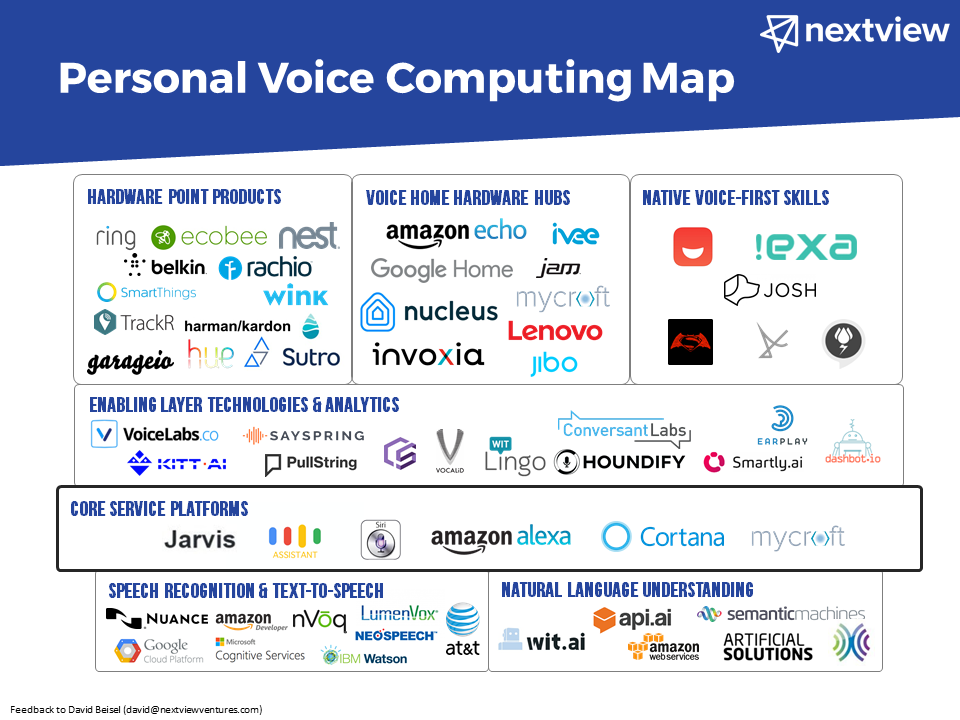David Beisel’s Perspective on Digital Change
A Personal Voice Computing Map
As we enter 2017 and millions of people received Google Homes and Amazon Dots+Echos as gifts over the holidays, an increasing amount of attention will be placed on Personal Voice Computing. I’ve recently been on a thematic pursuit exploring this space, and so I recently went looking for a market map to help orient me to the relevant categories and players. However, because I couldn’t find one, I decided with significant consultation help from others to create one. What follows is my first iteration of the voicescape, a map of the players in the Personal Voice Computing landscape:

A couple of caveats, thoughts, and insights on the above:
- While my aspiration is for this map to be both crisp and exhaustive, it’s in reality a work in progress reflecting a dynamic ecosystem. Some of the logos are products, some are companies, and some are acquired companies part of larger platform players, etc. I’ve attempted to place the important offerings in the right categories even when they straddle more than one. And I’ve certainly (unintentionally) left out companies and products which I should include.
- Because of the above, I’d very much welcome feedback – please comment or email me (david at nextview ventures dot com) with suggested additions and changes (and I’ll likely update soon with more accuracy).
- I intentionally didn’t include all of the “bot startups” which are not delibrately positioning themselves specifically for voice interactions. There is a whole industry of players in that adjacent market which requires much more extensive analysis, and the above specific exercise intentionally is limited to those bot/AI companies clearly and explicitly positioning towards voice. Admittedly, there is a lot of overlap and transference here which isn’t explicitly acknowledged in the graphic.
- By “native voice-first skills” category, I mean those voice “applications” that aren’t merely a replication of the same functionality of mobile or desktop computing translated to voice UI (i.e. ordering a pizza) but rather those skills which are uniquely take advantage of the new capabilities of the voice platform. See my previous post here on the subject. The candid reality is there just haven’t been many truly unique voice skills created yet, as most have been just toys.
- Because of the fact that there currently aren’t a lot of high-quality native voice-first skills, there is soon risk of an early media narrative backlash highlighting that while there are currently thousands of third-party skills created to date, none are really of that high quality. Part of that problem was an adoption issue which is fading every day – why would a serious developer spend significant time if not enough devices had been sold? However, a second component is a distribution issue which is still outstanding – there currently isn’t a good way for consumers to “discover” apps and for a developers skills to (virally?) proliferate.
- The large platform players are taking up many layers in the stack. Amazon has the devices, the core services platform, the powering layer, etc. Where is there (going to be) room for startups? Will they allow and empower a third-party skills ecosystem to thrive? Or does Amazon just eat all of the value?
- Speaking of platform companies, where is Facebook? They acquired voice-development tools startup Wit.ai in early 2015 and Mark Zuckerberg himself has recently talked about Jarvis, but they are clearly behind Amazon, Apple, Google, Microsoft in the race. But don’t count them out just yet, as it’s early.
We’re in the first inning here of the Personal Voice Computing ecosystem unfolding, and so I’m looking forward to feedback and updating this map as both the platform players make their strategic moves and nimble startups fill the empty holes.
